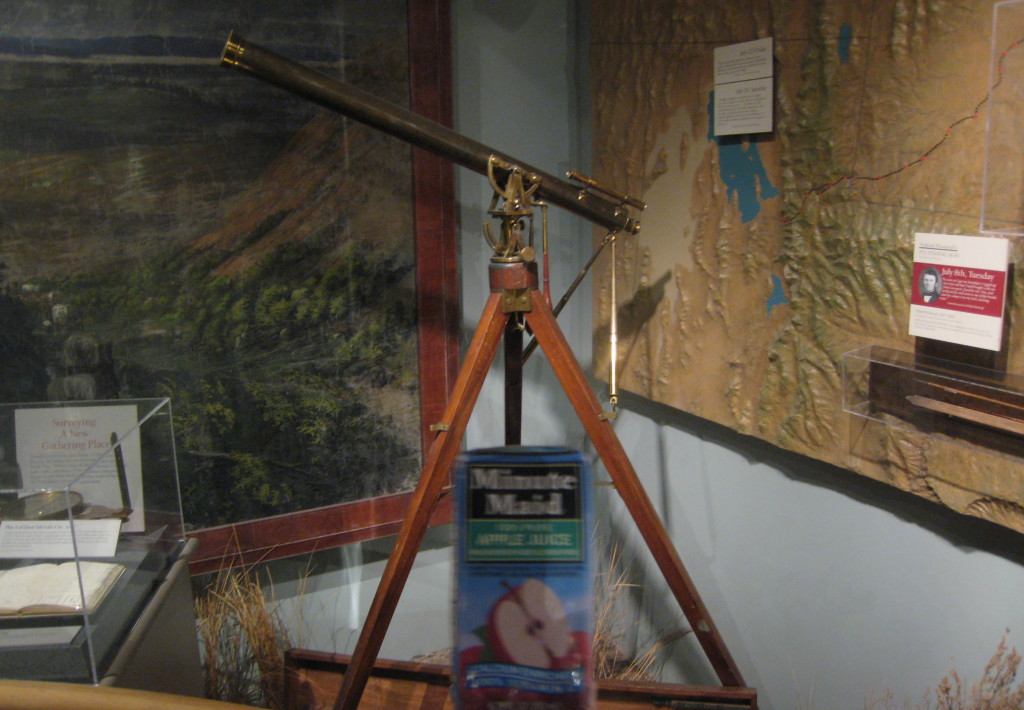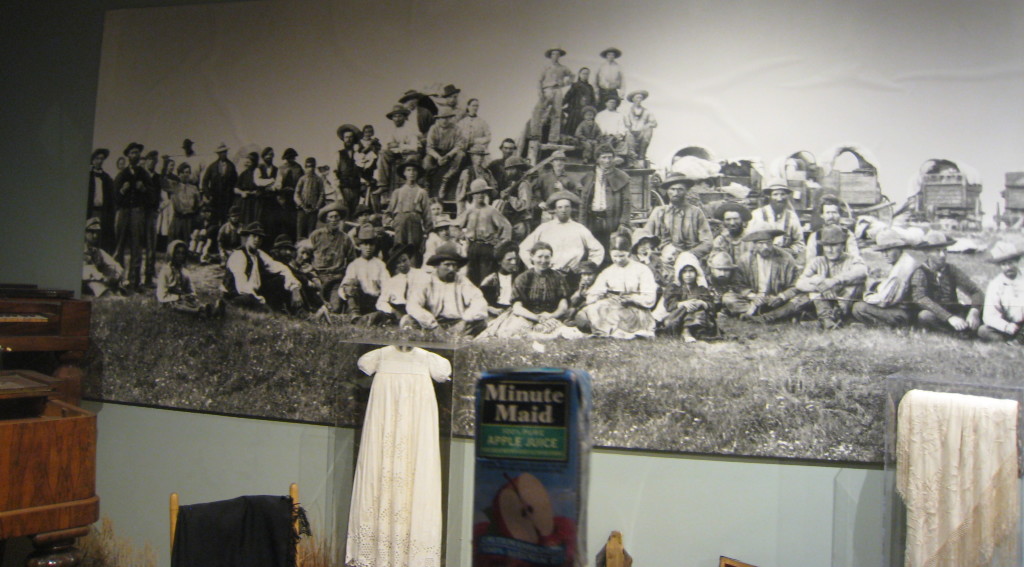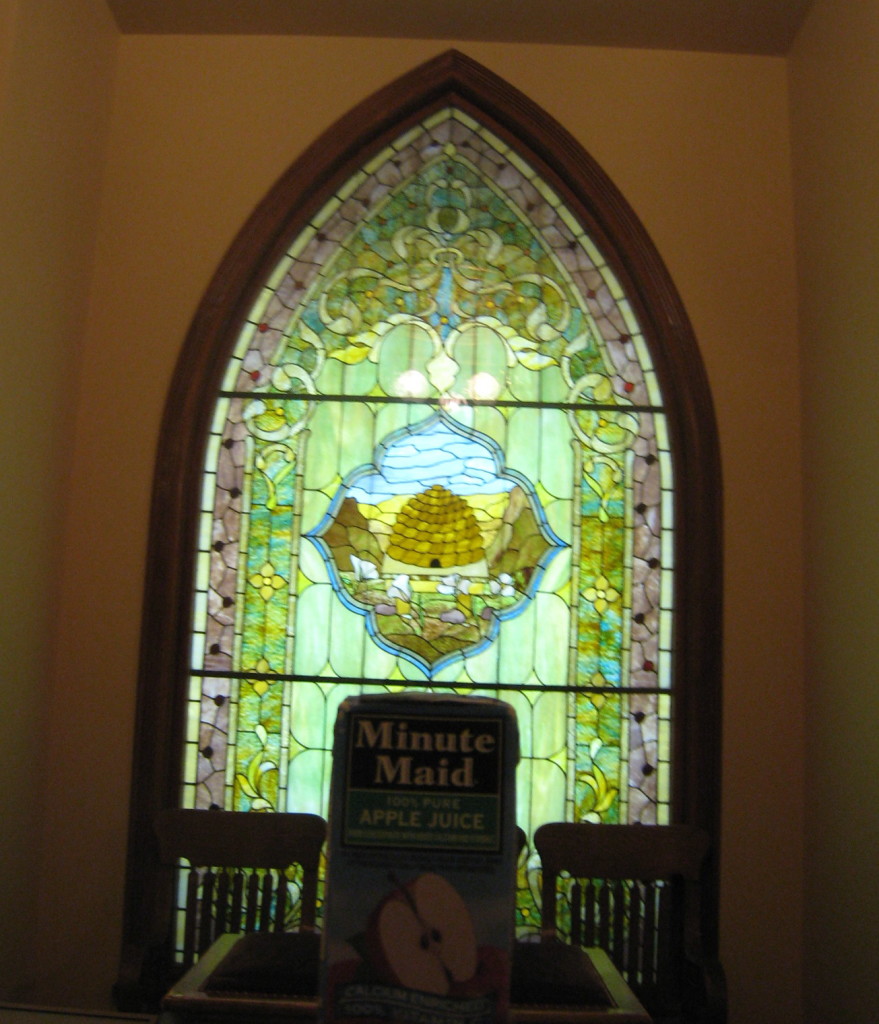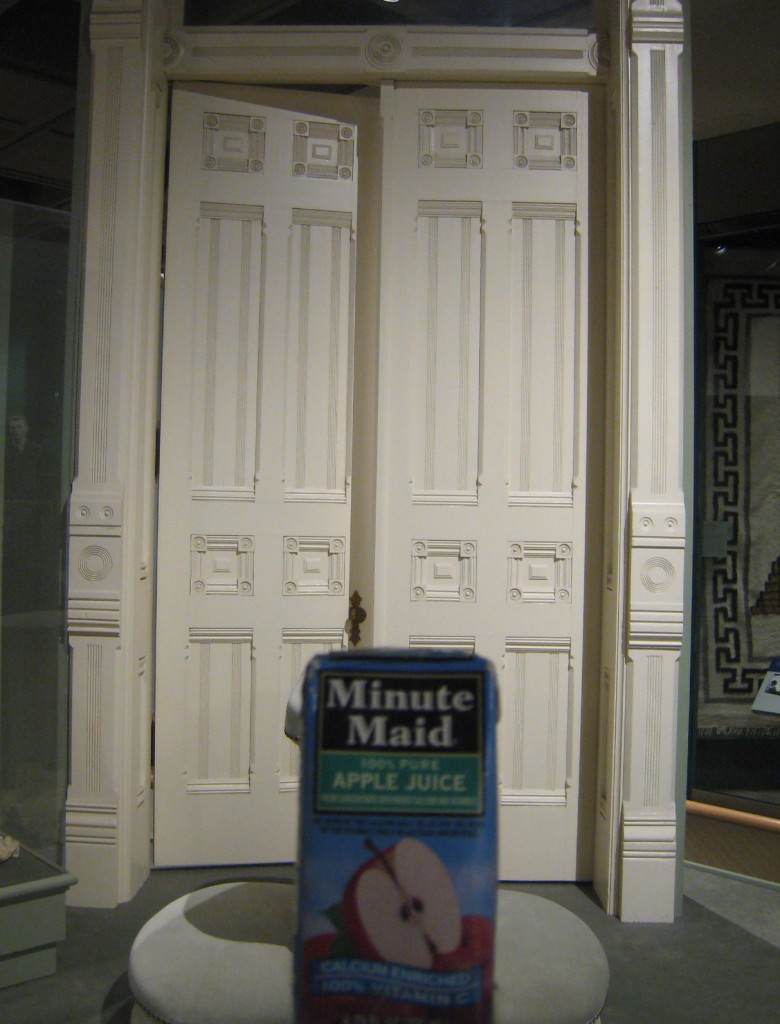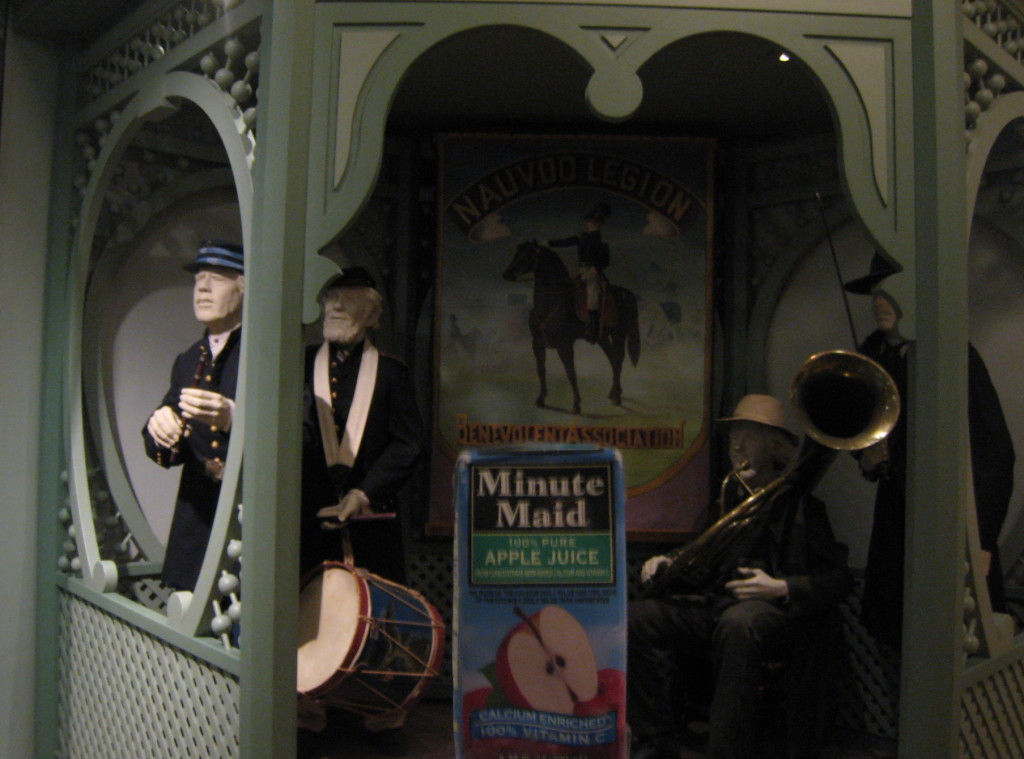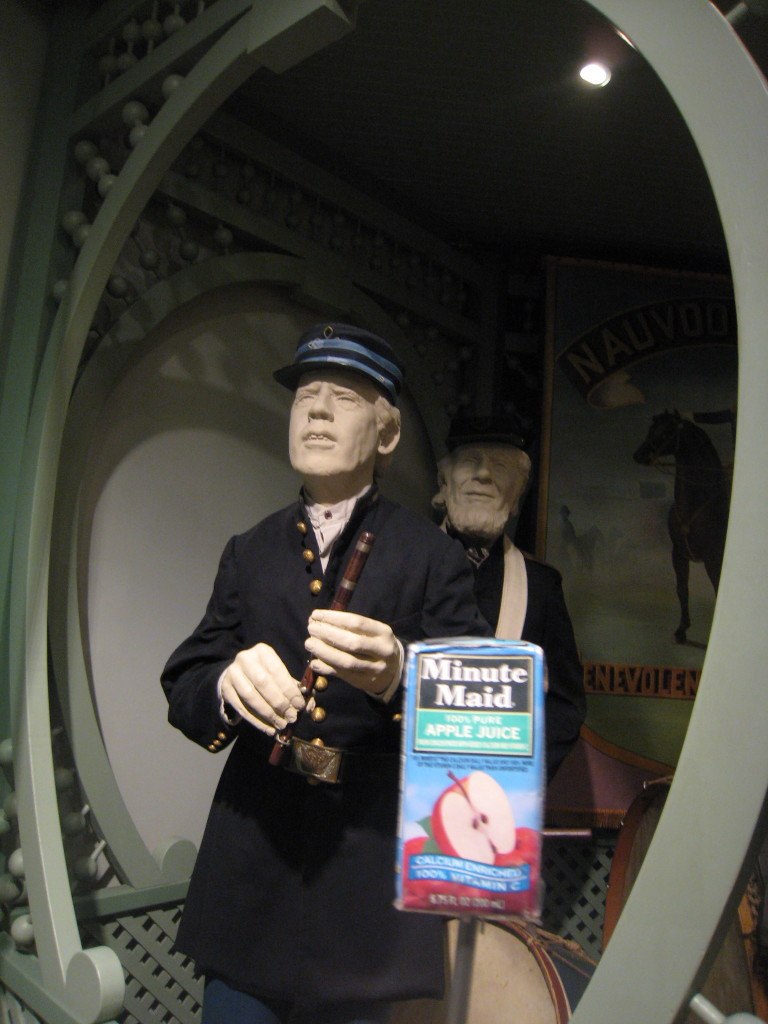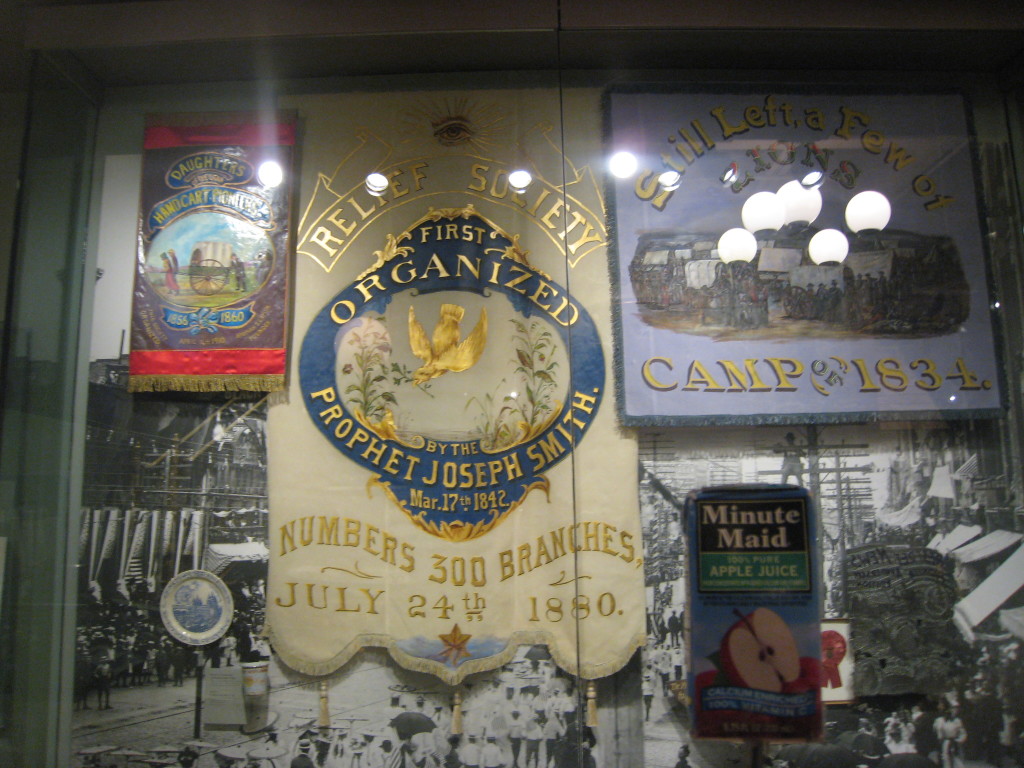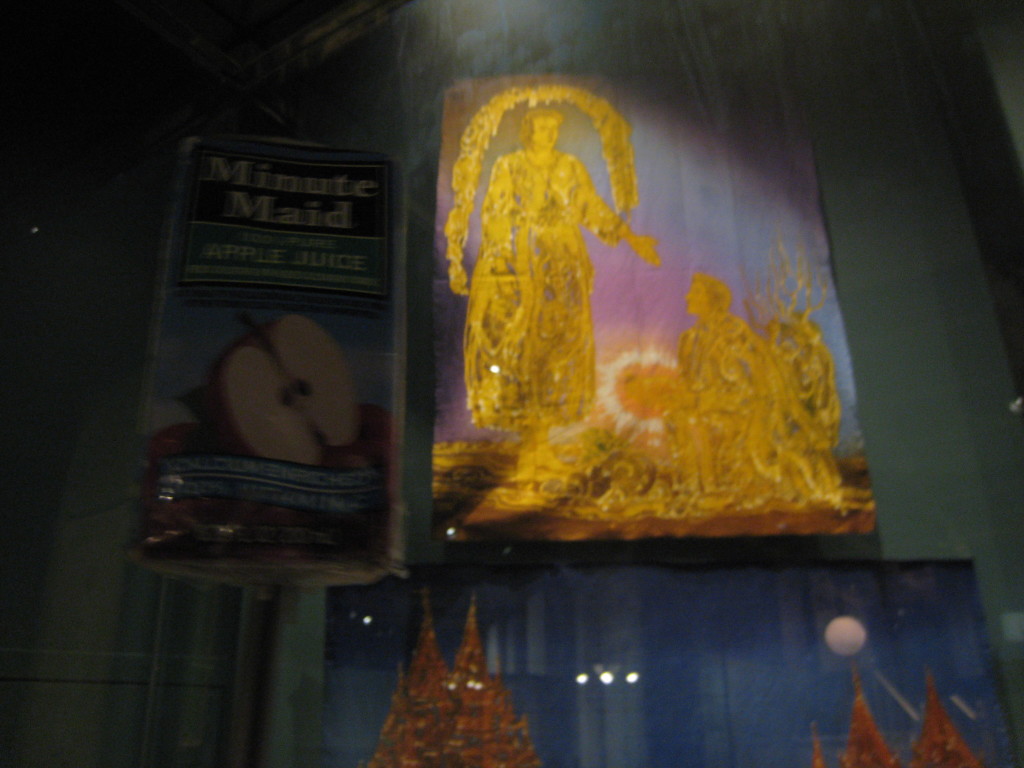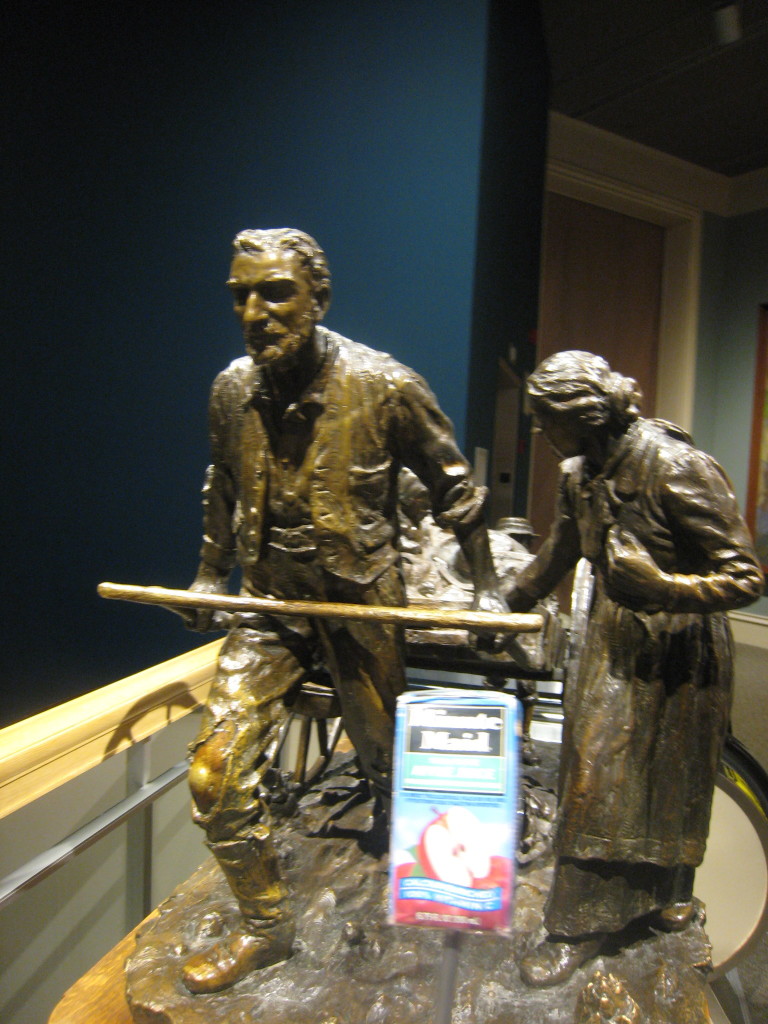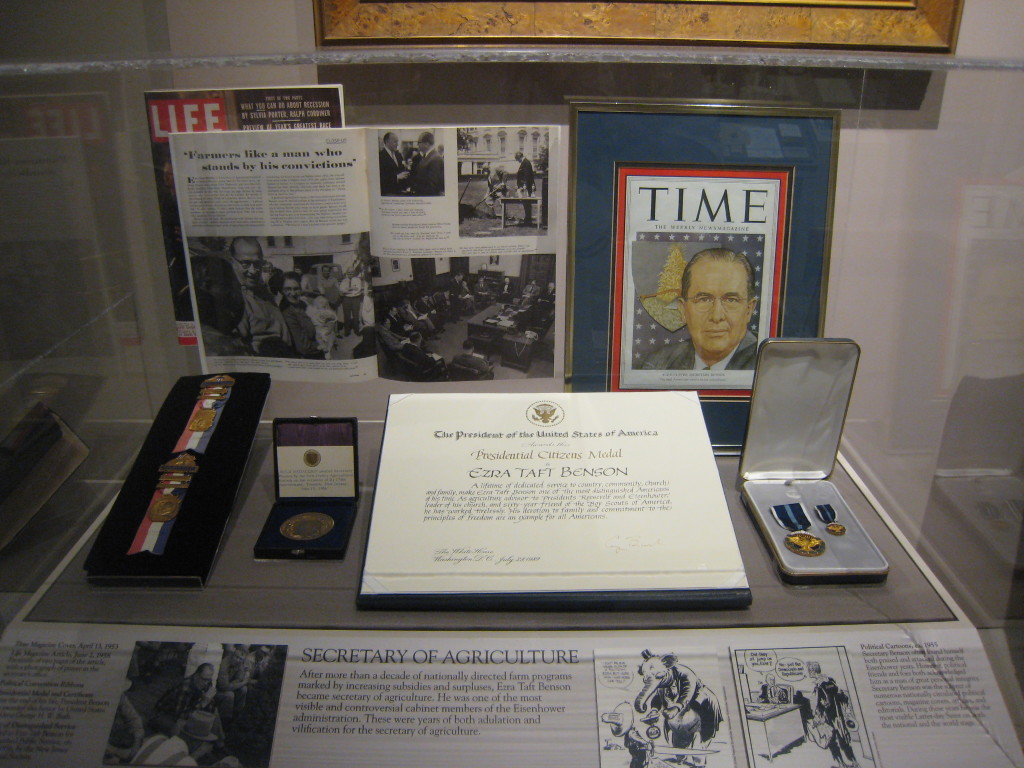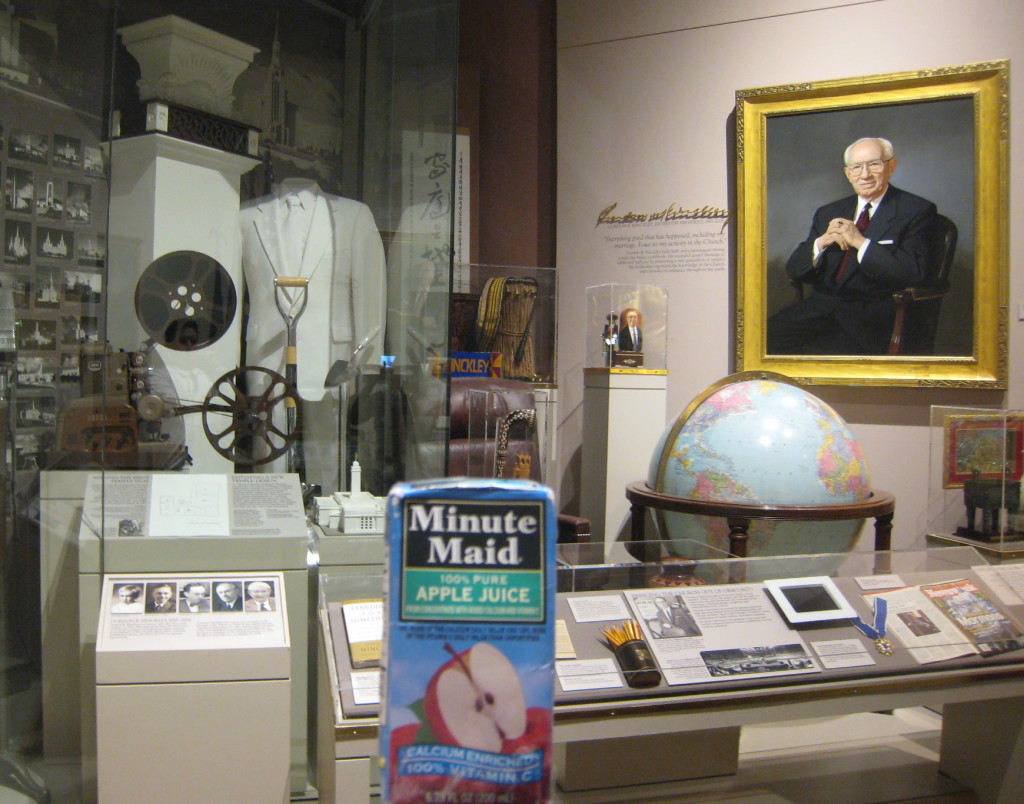Maid Appleton @ the Church History Museum in Salt Lake City, Utah
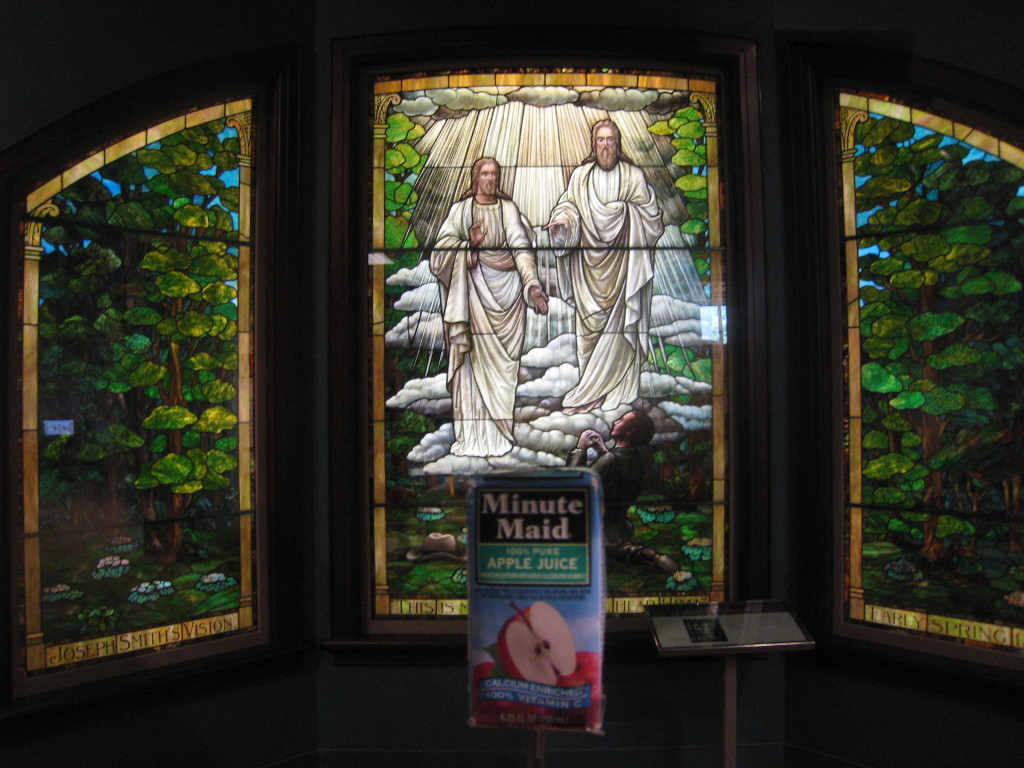
“Calling a Prophet, 1820 ~ ‘I saw two Personages, whose brightness and glory defy all description, standing above me in the air. One of them spake unto me, calling me by name and said, pointing to the other – This is my Beloved Son, Hear Him!'”

“The Coming Forth of the Book of Mormon” – E.B. Grandin Press – This ‘Smith Patented Improvement Press,’ which became available to printers in 1824, was used by Grandin to print the first edition of the Book of Mormon. Grandin purchased the press early in 1829.

“Nauvoo Temple Sunstone (Replica of the Original at the Smithsonian Institution) ~ The sunstone symbolizes the celestial kingdom-heavenly realm of God and the righteous who dwell with Him. Thirty sunstones carved from native limestone graced the walls of the Nauvoo Temple. This exhibit displays the sunstone as it looked in its nearly finished state. The top section (with trumpets) rests upon the sun-face for the stone carver to align the rays and smooth surface details. The stones were then hoisted in place separately and joined together atop the pilaster.”
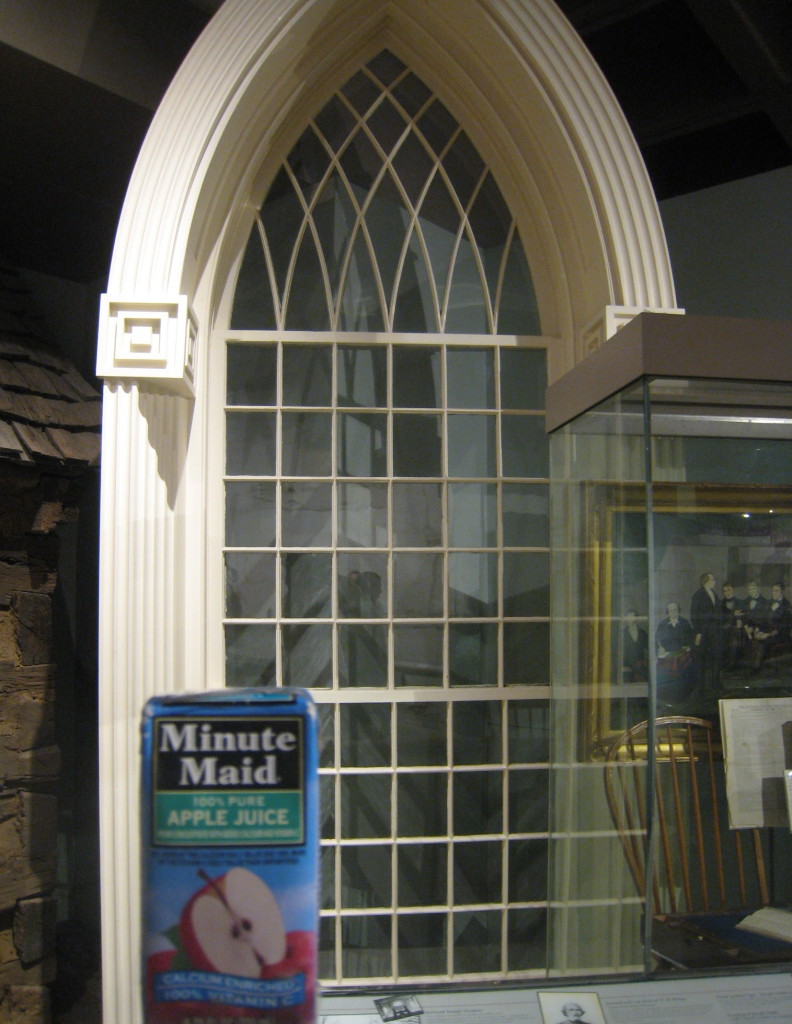
“Kirtland Temple Window ~ This window is from the main floor assembly room. Church leaders met frequently in the Kirtland Temple. Completed in March 1836, this temple served as a house of study, worship, counsel, and divine inspiration for Church members and their leaders. | Three-sectioned window sash courtesy of the Reorganized Church of Jesus Christ of Latter-day Saints. The attached frame and window sill are replicas of the original.”

“‘Old Sow’ Cannon ~ The Saints hauled this War of 1812 vintage cannon with them when they evacuated Nauvoo. It was intended as a display of self-defense while travelling across the Great Plains. The cannon later served as an unusual prop when the Saints arrived in the Salt Lake Valley. Wilford Woodruff recorded in his journal on July 25, 1847 that: ‘This is the first Sunday that any LDS ever spent in the Great Salt Lake Valley…Meeting was opened by the bishops and [Apostle] G. A. Smith preached the first sermon while standing upon the cannon.”

“Powder Horn ~ Owned by a member of the mob that murdered Joseph and Hyrum Smith, the powder horn is inscribed: ‘Warsaw Regulator/The end of the Polygamist Joseph Smith kilt at Carthage, June 27, 1844.” | Key and Doorlatch from Carthage Jail

“Death Masks of Joseph and Hyrum Smith ~ These original plaster impressions were made following Joseph’s and Hyrum’s deaths for Church members to preserve the memory of their physical appearance. (Joseph’s death mask is on the left, Hyrum’s is on the right.)”
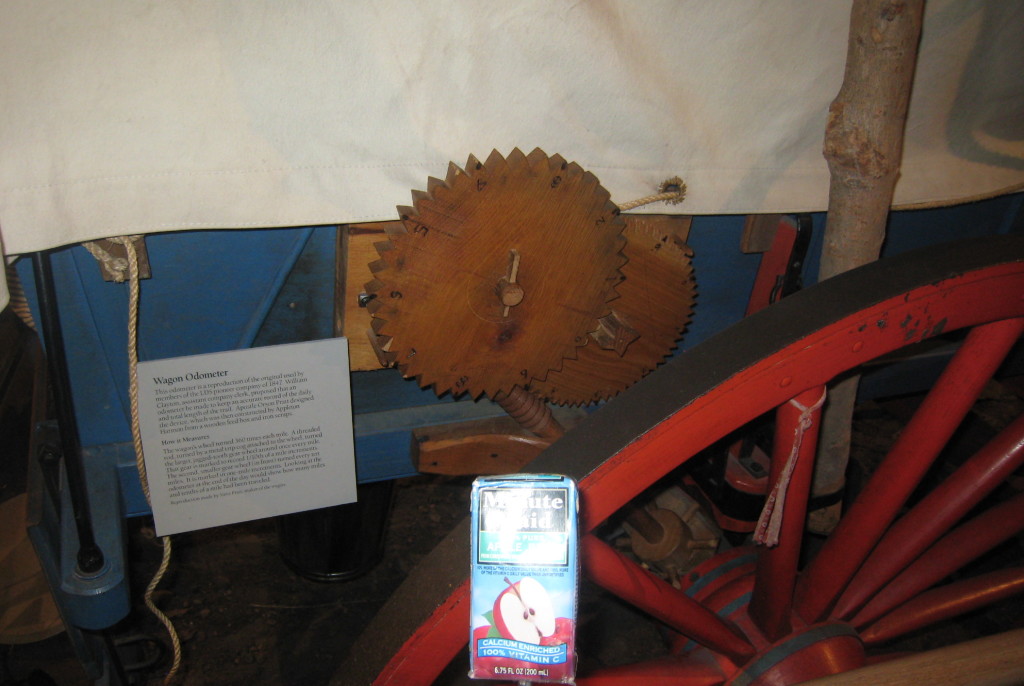
“Wagon Odometer ~ This odometer is a reproduction of the original used by members of the LDS pioneer company of 1847. William Clayton, assistant company clerk, proposed that an odometer be made to keep an accurate record of the daily and total length of the trail. Apostle Orson Pratt designed the device, which was then constructed by Appleton Harmon from a wooden feed box and iron scraps. | How it measures – The wagon’s wheel turned 360 times each mile. A threaded rod, turned by a metal trip cog attached to the wheel, turned the larger, jagged-tooth gear wheel around once every mile. That gear is marked to record 1/10th of a mile increments. The second, smaller gear wheel (in front) turned every ten miles. It is marked in one-mile increments. Looking at the odometer at the end of the day would show how many miles and tenths of a mile had been traveled. (Reproduction made by Steve Pratt, maker of the wagon).”
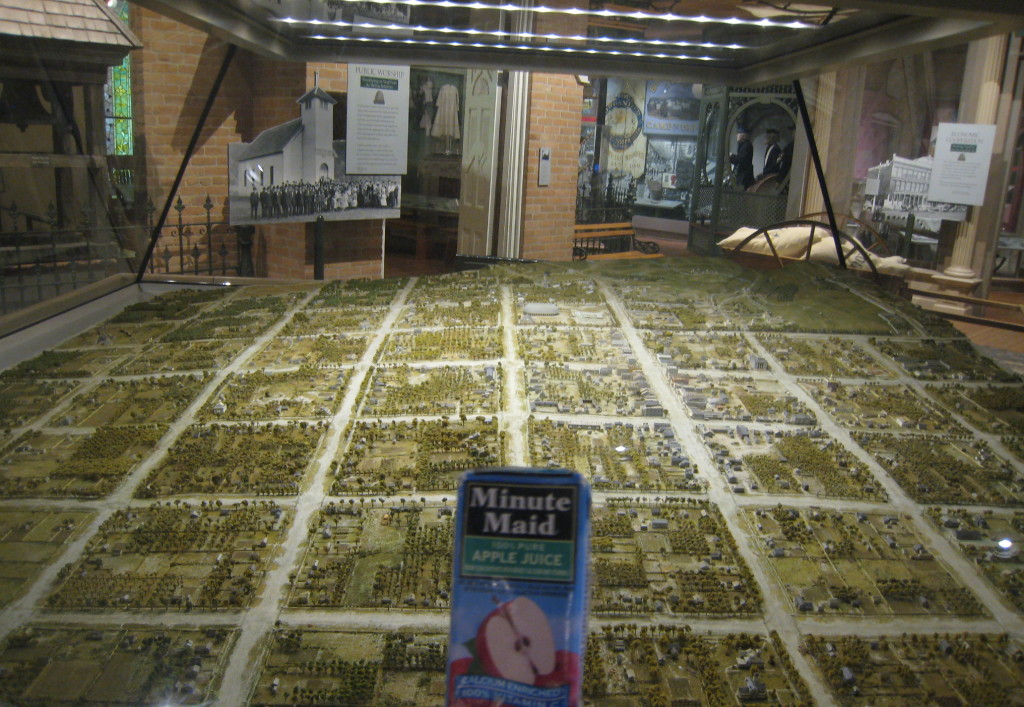
“Salt Lake City, 1870 ~ Salt Lake City was initially settled according to the ideals of the City of Zion. Thus pioneers laid out the city in a square grid oriented to the cardinal compass directions. The Temple Block provided a central referent for the city site. Business and residential areas were surveyed and numbered according to their distance from the temple. This urban plan strove to express the ideal religious orientation of Latter-day Saint settlements. | In 1870, residential neighborhoods were composed of well-built, single-family dwellings surrounded by irrigated kitchen gardens and orchards. They still maintained the sense or order, greenery, and domestic industry that Joseph Smith’s ‘Plat of Zion’ meant to introduce into the urban landscape.”
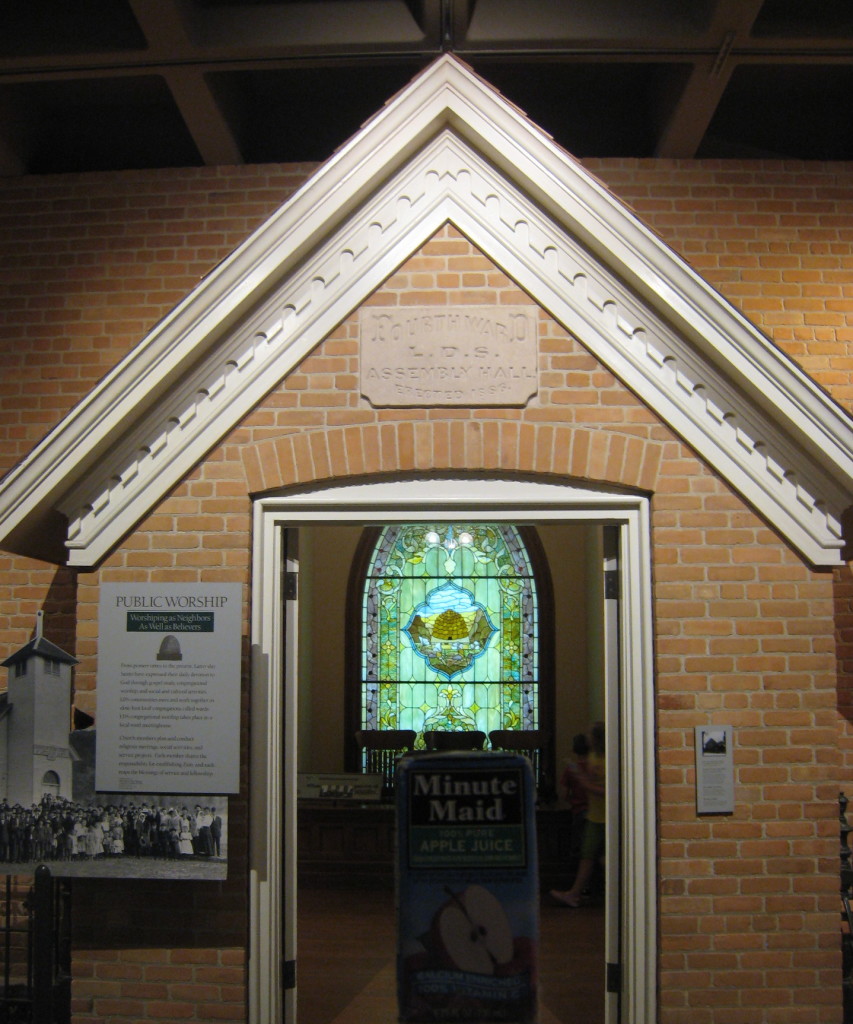
“Fourth Ward LDS Assembly Hall: (LEFT DOOR PANEL): Public Worship – Worshiping as Neighbors as well as Believers ~ From pioneer times to the present, Latter-day Saints have expressed their daily devotion to God through gospel study, congregational worship, and social and cultural activities. LDS communities meet and work together in close-knit local congregations called wards. LDS congregational worship takes place in a local ward meetinghouse. Church members plan and conduct religious meetings, social activities, and service projects. Each member shares the responsibility for establishing Zion, and each reaps the blessings of service and fellowship. || (RIGHT DOOR PANEL): Salt Lake City Fourth Ward Assembly Hall, about 1915 – courtesy LDS Church Archives : Fourth Ward Assembly Hall, Erected 1886 ~ Chapel entrance-including bricks, doors, cornice, and threshold-and ceiling decorations are from the Salt Lake City Fourth Ward. These architectural elements have been restored to their original finish. | Wrought iron fence – The fence is from Temple Square, where it surrounded the Deuel log cabin. The cabin is currently displayed on the Museum’s Plaza. | Paving Stones – The paving stones on which you are standing, were laid on South Temple Street In Salt Lake City in 1902.”
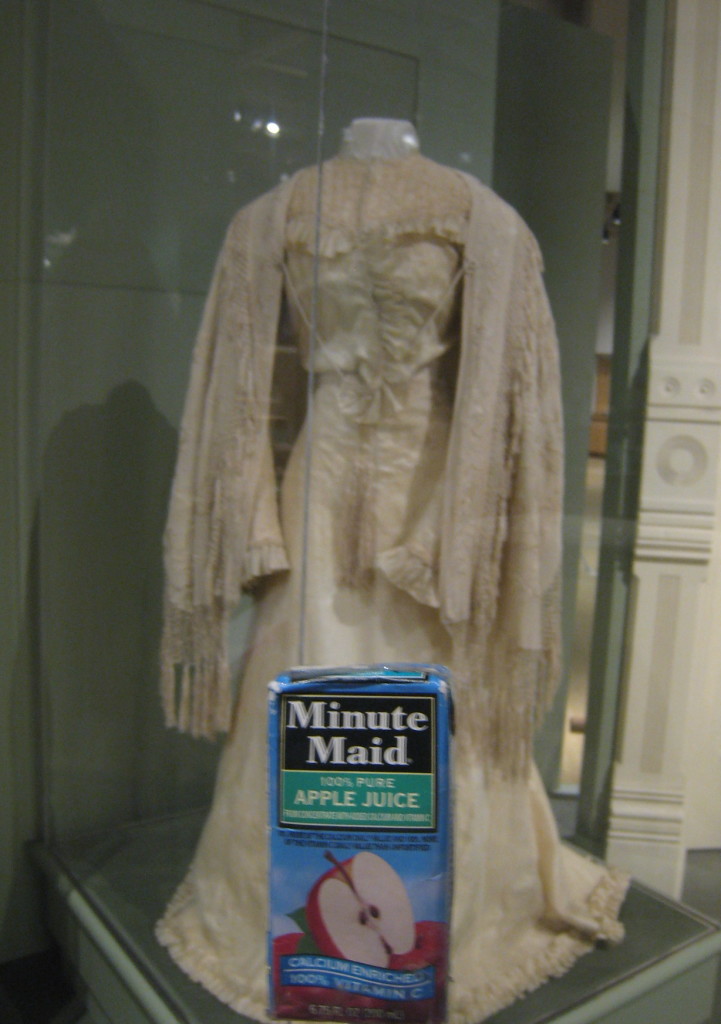
“Utah Silk Wedding Dress ~ Lucretia Wightman Miles wore this dress on her wedding day March 5, 1882. It was made from some of the first silk produced in Layton, Utah, at a time when the Saints strove for an economic self-sufficiency to match the independence of their religious beliefs.”

“We contemplate the human race past, present, and yet to come – as immortal beings, for whose salvation it is our mission to labor; and to this work, broad as eternity and deep as the love of God, we devote ourselves, now and forever. – Statement of the First Presidency, May 1907”
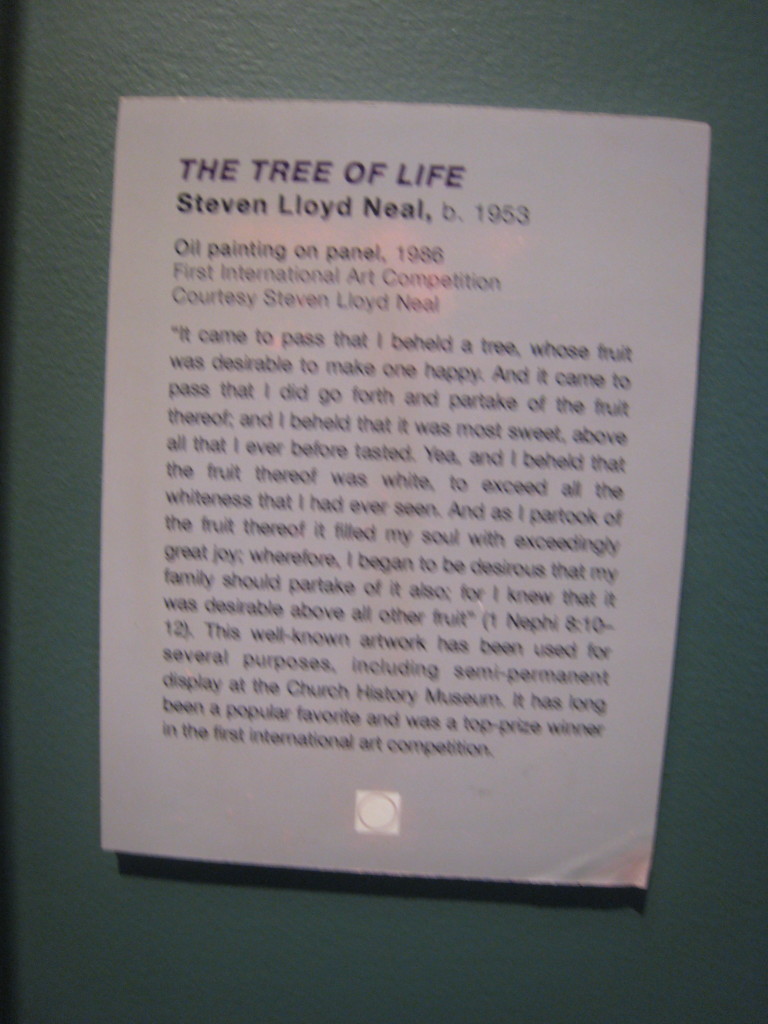

“The Tree of Life – oil painting on panel, 1986 by Steven Lloyd Neal (b. 1953) First International Art Competition ~ ‘It came to pass that I beheld a tree, whose fruit was desirable to make one happy. And it came to pass that I did go forth and partake of the fruit thereof; and I beheld that it was most sweet, above all that I ever before tasted. Yea, and I beheld that the fruit thereof was white, to exceed all the whiteness that I had ever seen. And as I partook of the fruit thereof it filled my soul with exceedingly great joy; wherefore, I began to be desirous that my family should partake of it also; for I knew that it was desirable above all other fruit’ (1 Nephi 8:10-12). This well-known artwork has been used for several purposes, including semi-permanent display at the Church History Museum. It has long been a popular favorite and was a top-prize winner in the first international art competition.”

“United States – ‘The Rod and the Veil’ by Franz Johansen (born 1928) – cast bronze sculpture, about 1975, museum collection”

“Venezuela – ‘Lehi’s Vision of the Tree of Life’ by Victor de la Torre, carved wood, about 1986 ~ Lehi’s vision of humanity’s quest for salvation is depicted in this carving by Brother de la Torre, a native of Ecuador who now lives in Venezuela.”

“Indonesia – ‘Joseph Smith Receiving the Golden Plates’ | Salt Lake Temple by R.M. Hadi Pranta (born 1932); Batiks (hand-printed textile), 1979-86 ~ Master batik-maker Pranato of Yogyakarta, Indonesia, used traditional designs and techniques to recreate sacred LDS events and buildings in these recent works. Brother Pranato was baptized in the Church in 1976, has served in branch presidencies, and continues a tradition of batik-making followed by his father.”
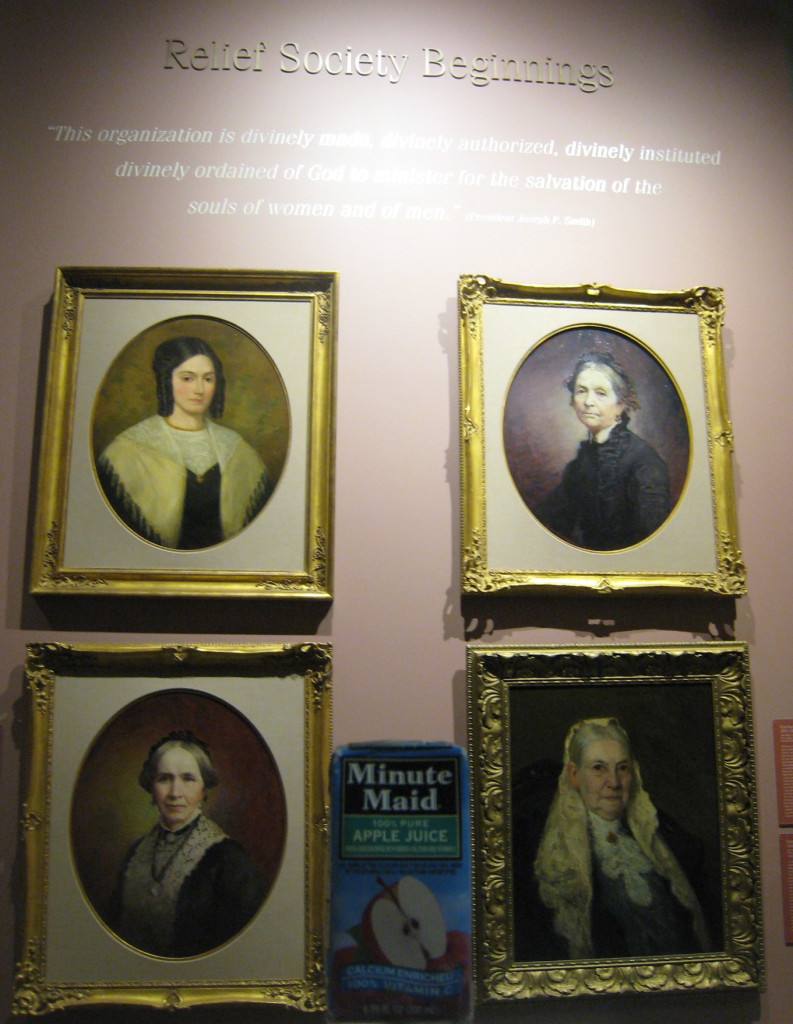
“Relief Society Beginnings ~ This organization is divinely made, divinely authorized, divinely instituted, divinely ordained of God to minister for the salvation of the souls of women and of men. – Pres. Joseph F. Smith”

“Handcart Pioneers (Bronze, 1926 by Torleif Severin Knaphus 1881-1963) ~ In this work of art, Knaphus honors the values of religious devotion and family solidarity exemplified by the experiences of the handcart pioneers. The pioneering family struggles against the weight of their meager belongings, which they are taking to their new homeland. The ‘gathering to Zion’ of these pioneers was done with their own hard physical labor. | Originally created in 1926, a life-size version of this scene was placed on Temple Square in 1945. | The artist was born and raised in Norway, where he began his art training. He joined the Church as a young man and emigrated to Utah. He continued his art studies in Paris and New York City. In addition to ‘Handcart Pioneers’, Knaphu created the ‘Hill Cumorah Monument’ near Palmyra, New York, to honor the coming forth of the Book of Mormon. He sculpted the baptismal font with twelve life-size oxen for temples in Mesa and Cardston, and the has relief architectural panel of Christ’s encounter with the woman at the well for the Alberta temple.”

“Christ and the Twelve Apostles – stained glass window, ca. 1925 – ‘He called unto him his disciples; and of them he chose twelve, whom also he named apostles’ – Luke 6:13 | Apostles in both ancient and modern times are specially called witnesses of the divinity and mission of Jesus Christ. This window was a gift from Mary Ellen Spencer Lonsdale to the Salt Lake Twelfth-Thirteenth Ward in memory of her parents, John and Mary Ann Butler Spencer.”

“Ezra Taft Benson – thirteenth president 1985-1944 ~’Let us all come unto Christ and be perfected in Him’ | Ezra Taft Benson encouraged Latter-day Saints to make the study of the Book of Mormon a cornerstone of their lives. His unflinching devotion to God, family, and country was a hallmark of his life.”

“Jerusalem Center for Near Eastern Studies ~ This architectural model shows a cross section of the Brigham Young University Jerusalem Center for Near Eastern Studies. The center was built on the slopes of Mount Scopus, just north of the Mount of Olives, near the Hebrew University, and overlooks the old city of Jerusalem. President Hunter dedicated the Jerusalem Center on May 16, 1989.”

“Gordon B. Hinckley (1910-2008) ~ Gordon B. Hinckley was born in Salt Lake City, Utah, on June 23, 1910. After graduation from the University of Utah and a mission to England, he began working an an employee of the Church, which led to a lifetime of dedicated service. On April 29, 1937, he married Marjorie Pay. | President Hinckley was called as an Assistant to the Quorum of the Twelve in 1958. He was sustained as an Apostle on September 30, 1961, and served as a member of the First Presidency beginning July 1981. He was set apart as President of the Church on March 12, 1995. He died in Salt Lake City on January 27, 2008.”
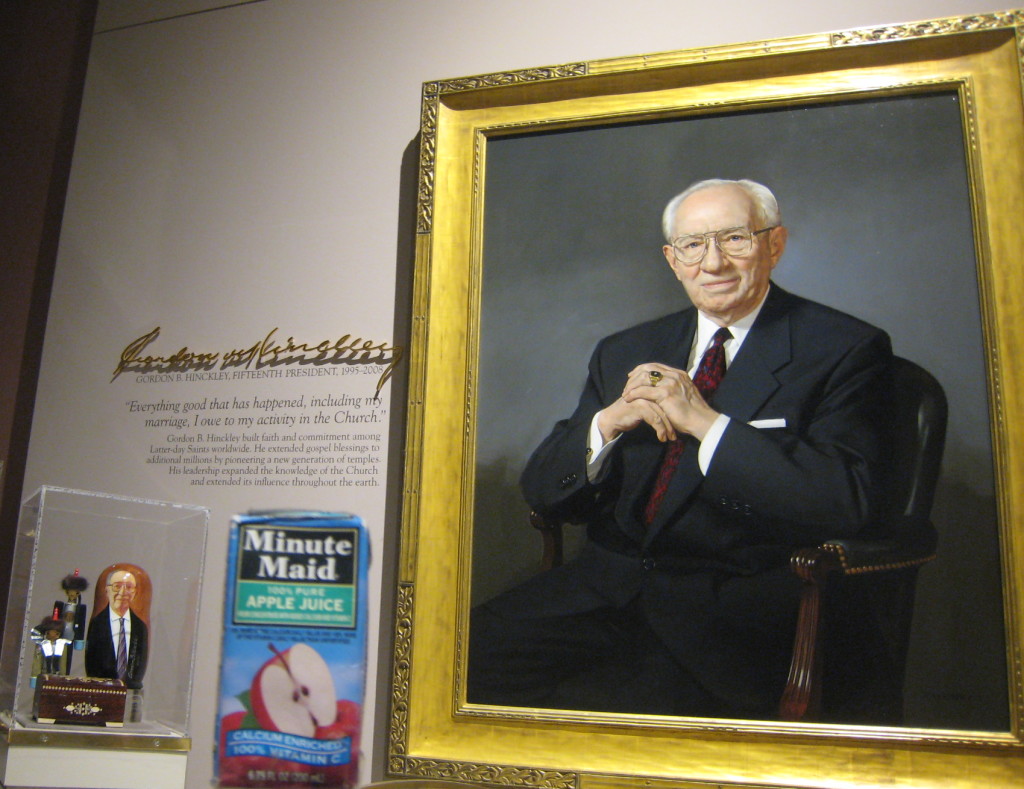
“Gordon B. Hinckley – fifteenth president 1995-2008 ~ ‘Everything good that has happened, including my marriage, I owe to my activity in the Church’ | Gordon B. Hinckley built faith and commitment among Latter-day Saints worldwide. He extended gospel blessings to additional millions by pioneering a new generation of temples. His leadership expanded the knowledge of the Church and extended its influence throughout the earth.”

“Spencer W. Kimball – twelfth president 1973-1985 ~ ‘Let us lengthen our stride’ | Spencer W. Kimball has led the Church with unusual spiritual power and energetic determination during a period of dramatic vitality and growth. His administration has produced significant advances in doctrinal understanding, member unity, and gospel expansion world-wide.”

“George Albert Smith, eighth president 1945-1951 ~ ‘I would not be any enemy to any living soul’ | George Albert Smith organized the Church’s massive welfare assistance to Europe following World War II. He also championed scouting among Latter-day Saints. Through numerous other civic and church responsibilities, President Smith lived that portion of his personal creed which declared, ‘I would be a friend to the friendless and find joy in ministering to the needs of the poor.'”

“Latter-day Saint Indian Art ~ This exhibit celebrates the long association of American Indians and The Church of Jesus Christ of Latter-day Saints. Drawn from a Church-sponsored collection begun in 1869, it features mostly art made by Latter-day Saint Indians. Also included are some works about Indians by other LDS artists and a few pieces by western American Indians who had early contacts with LDS pioneers. | From its beginnings in 1830, the LDS Church has maintained a fervent interest in the Indians of the Americas. One of its first organized missions was to Indians displaced by the federal government. This commitment reflected a desire to preach the gospel to these modern descendants of the ancient people described in the Book of Mormon. Latter-day Saint pioneers generally lived in harmony among tribes of the American West. Today, many Native Americans belong to the LDS Church. | This room is more than eighty years older than the rest of the building. The entrance, wood paneling, and fireplace in this room came from the lobby of the Bureau of Information that stood in the southeast corner of Temple Square from 1904 until 1976. The Bureau served as an information center and, with its 1919 addition, as a museum. The Museum of Church History and Art is a direct descendant of that institution. American Indian art was displayed in the lobby and the galleries of the Bureau of Information. This exhibit continues that tradition. | Indian members of the Church are encouraged to retain and develop the finest aspects of their traditional culture. Many of the Latter-day Saint Indian artists whose work is exhibited here rank among the leaders in contemporary American Indian art.”
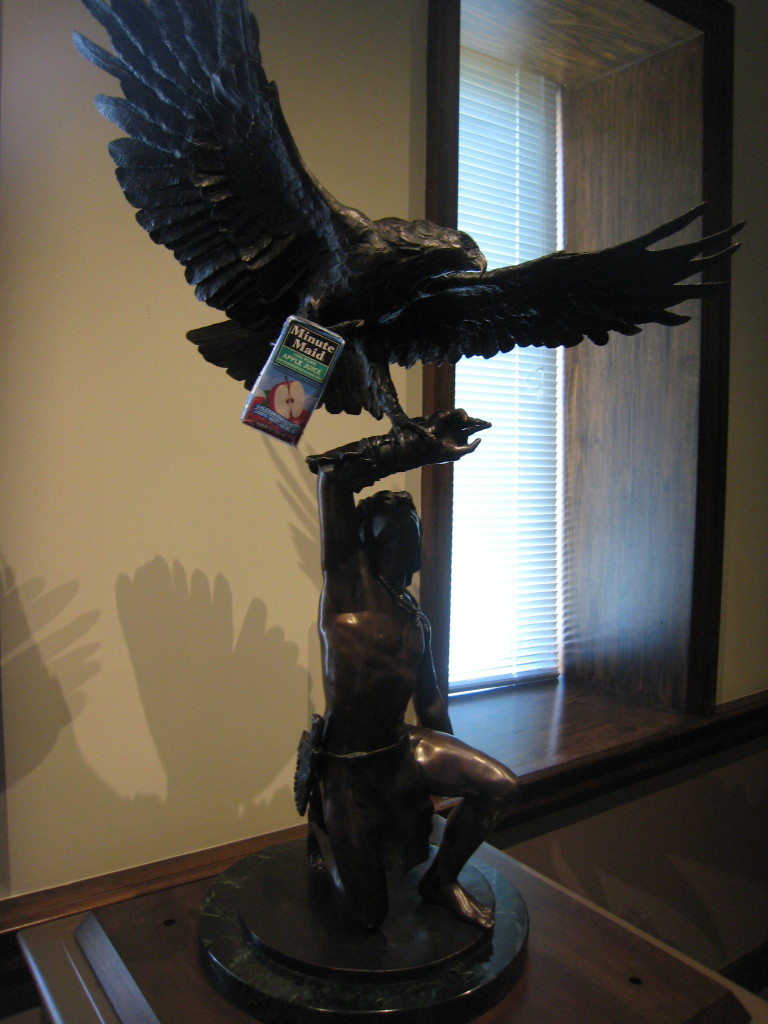
“Eagle Boy (Stanley Q. Johnson-1939 – __; Mapleton, Utah, 1981) ~ The Hopi tell the story of a chief’s son who was given an eagle to raise for a ritual sacrifice. The boy grew to love the eagle, and rather than see it killed, he set it free. As punishment, the boy was banished from his village. | In the wilderness, the eagle protected the boy and taught him to fish and hunt. Becoming lonely, the boy decided to return to his village. His people were frightened by his survival and knowledge. Assuming that he had survived by magic, the villagers had him bound. In an effort to drive him away, the youth of the village tied eagle feathers on his arms and back and taunted him. | Hearing the eagle’s call, the boy ascended a cliff and leaped. At the moment of leaving the ground he was transformed into an eagle and he flew to the sun.”
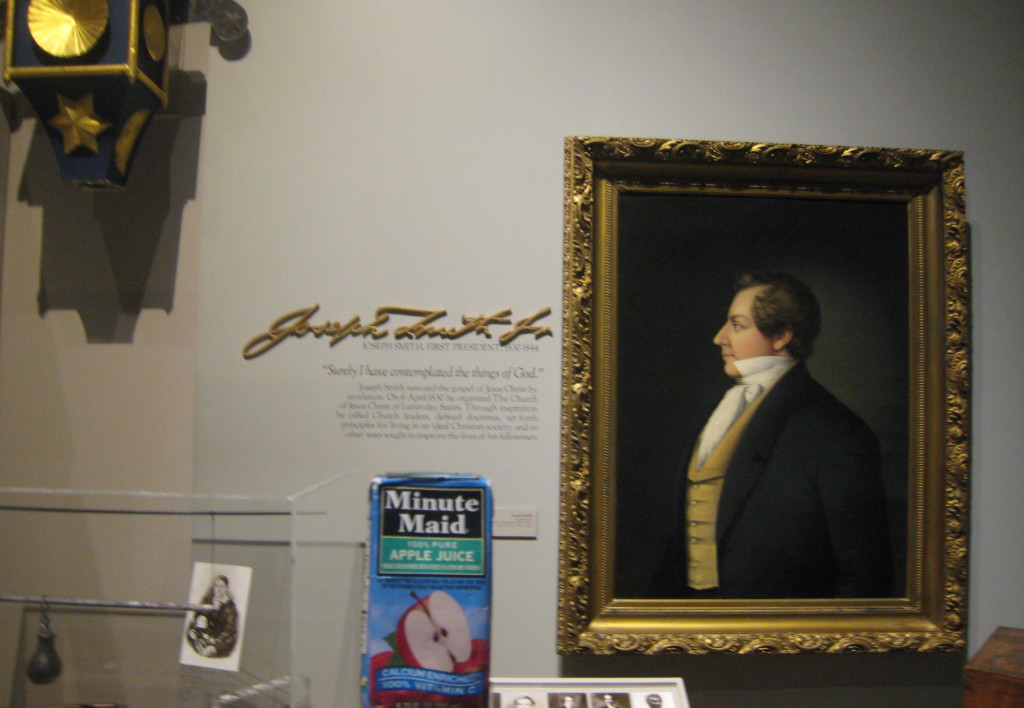
“Joseph Smith Jr. (Joseph Smith, First President 1830-1844) ~ ‘Surely I have contemplated the things of God’ – Joseph Smith restored the gospel of Jesus Christ by revelation. On 6 April 1830 he organized The Church of Jesus Christ of Latter-day Saints. Through inspiration he called Church leaders, defined doctrines, set forth principles for living in an ideal Christian society, and in other ways sought to improve the lives of his fellowmen.”

“Joseph Smith Preaching to the Indians (oil on canvas, ca 1890 by William Armitage (1917-1890) ~ Several times in Nauvoo, Illinois, Joseph Smith met with local Indians. This painting probably depicts the August 12, 1841, visit of more than one hundred chiefs and braves of the Sac and Fox Indians and their families. During a meeting in the grove below the temple, the Prophet explained the Book of Mormon. He told them of the special religious commitment that Latter-day Saints have to Native Americans. | William Armitage, an English convert in 1853, immigrated to Utah in 1881. His highly stylized painting reflects formal academic training. He depicts Indians as idealized classical figures rather than real Native Americans. His ‘noble savages’ reflect an artistic and literary tradition popular for a century. Armitage had probably never visited Nauvoo. He includes Utah mountains as a backdrop as another idealized element to ‘ennoble’ the event. | Joseph Smith’s pose is borrowed from other paintings of him preaching. The left hand holds a copy of the Book of Mormon. The bearded man behind the Prophet is unidentified. | This painting was commissioned for the Salt Lake Temple. It hung there, along with Armitage’s painting of Jesus visiting the Nephites, for over fifty years. More recently, it was shown at the LDS Visitor’s Center in Independence, Missouri.”














